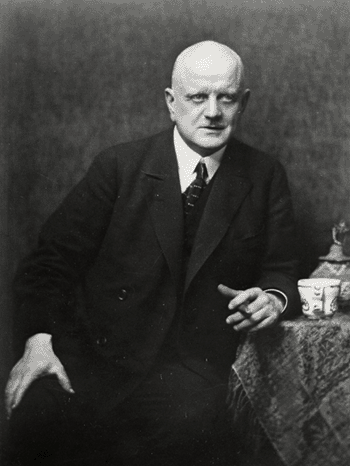 Jean Sibelius (1865-1957): A Reserved Finn with White-Hot Passion Within
Jean Sibelius (1865-1957): A Reserved Finn with White-Hot Passion Within
by Barry Lenson
If you ask a group of music lovers to tell you something about the Finnish Composer Jean Sibelius, at least 10 of them will answer, “He wrote Finlandia.”
Those people would be correct. Sibelius did indeed write the tone poem Finlandia in 1899. But Finlandia is hardly representative of most of his music. That piece is essentially an orchestral hymn to his country, with an optional choral accompaniment. Though beautiful and beloved, it never approaches the emotional depth that can be found in most of Sibelius’s works, which have been described as “arid,” “bleak,” and even “despairing.”
So who was this composer, beyond Finlandia? Let’s explore.
Early Life and Education
Jean Sibelius was born on December 8, 1865, in Hämeenlinna, Finland. His father, a physician, died of typhoid when Jean was just three years old, leaving the family in financial distress. Although Swedish was spoken in his home, Jean attended a Finnish-language school, where he developed a deep love of Finnish culture.
Sibelius initially pursued a career in law but soon abandoned it to focus on music. He studied at the Helsinki Music Institute (now the Sibelius Academy) under Martin Wegelius and later continued his studies in Berlin and Vienna with renowned composers Robert Fuchs and Karl Goldmark. Although he aspired to be a violinist, his true calling was composition.
Rise to Fame
Sibelius’s first major orchestral work, the Kullervo Symphony, premiered in 1892 and was met with great acclaim. This success was followed by other significant works, including En Saga (1892) and the Karelia Suite (1893). These early works were based on Finnish mythology and the Finnish national epic, the Kalevala.
In 1899, Sibelius composed Finlandia, a tone poem that became a symbol of Finnish nationalism and resistance against Russian oppression. The piece’s powerful and evocative music resonated deeply with the Finnish people and played a crucial role in shaping the country’s national identity.
Symphonic Mastery
The core of Sibelius’s oeuvre is a set of seven symphonies, composed between 1899 and 1924. These symphonies are celebrated for their innovative structure, rich orchestration, and profound emotional depth.
Many listeners have observed that Sibelius’s music reflects his deep connection to nature. To be sure, he found inspiration in the Finnish landscape, and this is evident in works like The Swan of Tuonela from the Lemminkäinen Suite (1895) and the tone poem Tapiola (1926).
Later Years and Legacy
After completing his Seventh Symphony in 1924 and Tapiola in 1926, Sibelius entered a period of creative silence that lasted for the remaining 30 years of his life. Despite numerous attempts, he never completed his much anticipated Eighth Symphony, and it is believed that he destroyed the manuscript.
Sibelius spent his later years at his home, Ainola, in Järvenpää, Finland, with his wife, Aino. He continued to revise and edit his earlier works and composed some smaller pieces, including Masonic ritual music. He remained an influential figure in Finnish cultural life and was celebrated for his contributions to music and national identity.
Jean Sibelius passed away on September 20, 1957, at the age of 91. His legacy endures through his music, which continues to be performed and cherished worldwide.
Important Compositions by Jean Sibelius to Hear on Classical Archives*
Finlandia, Op. 26 – A tone poem that became a symbol of Finnish nationalism.
Karelia Suite, Op. 11 – A suite of three movements inspired by Finnish history and folklore.
Violin Concerto in D minor, Op. 47 – A virtuosic and lyrical concerto for violin and orchestra.
Symphony No. 1 in E minor, Op. 39 – The first of his seven symphonies, showcasing his early romantic symphonic style.
Symphony No. 2 in D major, Op. 43 – Known for its heroic and uplifting character.
Symphony No. 5 in E-flat major, Op. 82 – Famous for its majestic finale inspired by swans in flight.
Symphony No. 7 in C major, Op. 105 – A single-movement symphony that represents his mature style.
Lemminkäinen Suite, Op. 22 – A suite of four tone poems for orchestra completed in 1896.
Tapiola, Op. 112 – A tone poem evoking the spirit of the Finnish forests.
Night Ride and Sunrise, Op. 55 – This remarkable tone poem depicts a solitary man on a night journey across the wilderness. The sunrise that occurs at the end of this piece is one of the glories of classical music.
* Please note that in order to listen, you must be a member of Classical Archives. If you are not yet a member, we invite you to join now. Free 14-day trial memberships are now available.
Jean Sibelius’s music remains a testament to his genius and his profound connection to his homeland. His works continue to inspire and captivate audiences, ensuring his place as one of the greatest composers in the history of classical music.





Recent Comments